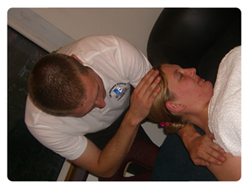The usual routine for a Remedial massage for new patient will be as follows:
History
Here I will spend significant time to find out as much relevant information ranging from previous injuries to hobbies and work patterns. This can be crucial in determining the cause of the problem.
Visual Check
The aim here is to take a general look at the area in question to try and compare the affected and unaffected sides of the body. This may require the patient removing their outer clothes for a brief period of time in order to build up a complete picture.
Feel
Palpation, or feeling the affected area, aims to check for any muscle imbalance and the integrity of the surrounding joints and muscles.
Movement
If not immediately clear where a problem may be originating from, some moves will be performed in order to try and pinpoint to exact area of concern.
Massage
Once the problem has been identified, and if the problem can be aided and treated by massage and mobilisations, then massage is the next step. Massage generally involves three stages (though within each stage there may be several different components):
- The first is to relax the patient, increase blood flow, and prepare the muscles for further deep tissue work.
- The second stage involves a little more contact with muscles and is designed to loosen any adhesions and increase lymphatic flow.
- The third stage is probably what most people associate with massage – fast moving hands with loud clapping noises. This stage is designed to induce muscle tone and helps the muscles to contract a little after all the softening of the previous stages.
In between steps two and three there are a number of techniques which are can be used depending on the nature of the problem. In some cases it is more beneficial to use trigger point therapies. These methods are more directly linked to the actual treating of the muscle pain in question.
Sometimes these are not needed and the best treatment after a good massage is to use voluntary contraction and release methods otherwise known as PNF (Proprioceptive Neuromuscular Facilitation). It may be necessary to use any of these other techniques but in some cases a combination of two or three may be used depending upon the situation.
If you would like to know more about trigger points then you can do by reading this Massage Hands article about Trigger Point Therapy.
During the massage you may need to remove all clothes to your underwear to improve access to the whole body. However, only the part under treatment will be exposed, and the rest of the body will be covered by towels to keep you warm and comfortable at all times.

“At all times, the patient will be made as comfortable as possible.”
Mobilisations
These are movements performed after the massage while the muscles are still soft and warm. The mobilisations are designed to complement the massage and aid the recovery process.
Rehabilitation advice
To gain the most from the massage treatment, a series of additional exercises between treatments may be required. This may be of particularly importance to professional or semi-professional sportspeople, or those employed in physical jobs, where speed of recovery is vital.
If they will be of benefit, post-treatment, I will provide exercises which target the affected areas to help re-build the muscle tone and increase flexibility. These simple exercises can greatly increase the likelihood of a speedier return to a more normal use of the joint or muscle in question.
I sit at a desk for most of my day in front of a computer. I don’t get to move about too much and I think as a result of this over time I have developed a rather sore lower back and sometimes shoulder problems.
I went to see Stephen when the pain was just too much to bear anymore. I must admit the treatment was no ride in the park as it was painful at times but it was worth every last bit of it. I was feeling the benefit after just a few sessions of treatment.Since September last year I have been pain free and just need the occasional treatment to put me back on track. Stephen is a great guy who is very professional and easy to talk to. He gives constructive advise and is there whenever you need him. I wouldn’t hesitate to recommend anyone to see Stephen if they are in a similar pain.
Jo Oakes
